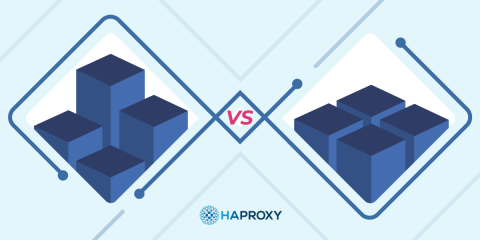
HAProxy. High availability and a reverse proxy–it’s in the name, but what does it all mean? Before understanding how the two concepts work together in the load-balancing space, we need to unpack the basics of high availability and how a reverse proxy functions. In this blog post, we explore:
the gold standard of high availability;
the difference between a forward proxy and a reverse proxy; and
how high availability and a reverse proxy come together to provide solutions for business needs.
What is High Availability?
High availability has become the gold standard for how critical systems operate. High-availability systems perform at a higher-than-normal level, running nearly 100 percent of the time. This is often referred to as the “five-nines” availability, quite literally meaning an uptime of 99.999%.
With certain systems and operations, there’s no room for failure. Finance, health care, and technology are just a few of the sectors whose critical infrastructures depend on high availability to keep their data and applications accessible. Without high availability, financial data and personal information can become inaccessible, and this can affect the well-being of customers, the ability to purchase goods, and the capacity of a business to make important decisions. High availability allows these services to operate uninterrupted and consistently. It provides business leaders peace of mind and offers their service users security, knowing they can always depend on their system.
Put simply, high availability systems keep the vital infrastructures of our modernized world functioning. It ensures there are no pain points in digital services, eliminating the possibility of failure, and offers a seamless and reliable experience for both operations and clients.
This standard of operating has become more important than ever, but what does high availability mean when it comes to a reverse proxy? Before unpacking, we need to understand how a proxy functions.
Related Articles:
What is a Reverse Proxy?
A proxy is something that sits between two points of communication and is authorized to act on behalf of one of those points. Typically, a proxy is someone who is permitted to gather information and take action on behalf of another person. In computing, a proxy is something that operates between the client and the server and can take action on the information being sent or received between the two. Whether the proxy manages incoming or outgoing requests depends on whether it is a forward proxy or a reverse proxy.
A forward proxy manages outgoing information that is leaving the client and being sent to the server. The forward proxy controls whether the client has access to such information and whether the request will reach the server. The most common example of a forward proxy is in the workplace where a forward proxy blocks employee access to certain websites that can be harmful to their systems and networks. If an employee requests access to such websites or applications, the forward proxy can deny the request for information before going out.
A reverse proxy is simply the opposite of a forward proxy, sitting on the other end of the relationship between client and server. A reverse proxy manages incoming information and requests before it hits the server and application. It is essentially a traffic controller, determining where the requests will go, ensuring all the information is received and blocking any threats to cybersecurity. The traffic controlling capabilities of a reverse proxy means it functions well as a load balancer, efficiently distributing requests across a fleet of servers to ensure the best possible performance.
High Availability & Reverse Proxying as a Solution
Now that we have an understanding of what high availability and a reverse proxy are, what happens when they are offered as a single solution? We’re talking about a reverse proxy that is able to provide high availability to applications upstream and efficiently manage incoming traffic and threats–a key component in designing solutions that can offer five-nines availability. This technology ensures consistent and reliable website and application performance, protects against malicious attacks, and ensures servers are not overloaded, meeting every. single. demand.
That’s what HAProxy Technologies is all about.
From load balancing solutions to application acceleration, the benefits of a high availability reverse proxy for services and applications are many, but we’ll take a deeper dive into those solutions as our Fundamentals series continues.
Subscribe to our blog. Get the latest release updates, tutorials, and deep-dives from HAProxy experts.



